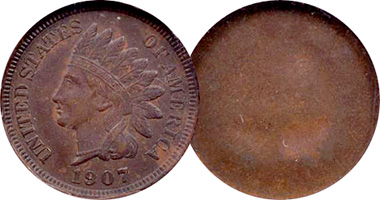One-Sided Pennies Guide
Let's look at the curious case of one-sided pennies: How do they happen? How valuable are they?
Value of One-Sided Pennies
In many cases a one-sided penny will sell for hundreds of dollars at auction, provided it has been professionally graded.
By their nature, errors are rare coins. Very small quantities exist for any particular error coin. This makes them much more valuable than their more common counterparts. But prices for individual error pennies will differ. Its value will be based on its rarity, condition, and collector tastes at the time.
For these reasons, it's difficult to give a precise price range for a one-sided penny. Values are determined on a case-by-case basis. It's still a good idea to look up auction results to get a general sense.

Image of a uniface Indian Head penny courtesy of Sullivan Numismatics
Next we'll consider how a one-sided cent can occur. This biggest factor that influences how much the coin is worth.
Two Causes of One-Sided Pennies
Also called uniface coins, a coin with a design on only one side can occur for two reasons:
1. The result of an error at the mint that made the coin
2. The result of damage that happens after being minted
The way in which a one-sided coin is created has a huge impact on its value. Let’s look at both scenarios.
1. Minting Errors
Mistakes that occur at the mint create "error coins." These are the types of error coins that are potentially worth a lot of money.
Error coins are especially rare because they are never intended to leave the mint. The fact that they make it into circulation is an unusual oversight. Finding a genuine one-sided nickel error is indeed a very rare occurrence.
We'll explore two kinds of mint errors that could result in a one-sided pennies:
- Brockage error: The result of a coin getting stuck to another coin during the minting process. The usual result is a mirror image of the design appearing on the opposite side of the coin, but one side of the coin may have such faint details that it appears blank.
- Die cap error: When the planchet gets stuck to the hammer die used to strike the coin. Not only does this leave one side of the coin blank, but it also gives it a shape resembling a bottle cap.
You can learn even more about uniface error coins from resources like CoinQuest.com.
2. Damage After Minting
Coins that become damaged after leaving the mint are worth virtually nothing, unfortunately. Any post-mint damage that results in a one-sided coin is not considered valuable. How can you tell if this is the case? Here's how it can happen:
- Circulation wear: Excessive wear can obscure one side of a coin. This is the most common cause of all uniface coins in existence—making the true error coins that much more rare and valuable.
- Accidental damage: Coins that endure bending, breaking, or other forms of physical damage may end up with a one-sided design.
Collecting One-Sided Coins
Here are some tips for anyone interested in collecting error coins like one-sided pennies:
Read more about collecting valuable pennies from our numismatic experts:
Coin Glossary: Most Important Coin Collecting Terminology
10 Most Valuable Pennies: Are These in Your Pocket Change?
What Are the Different Penny Errors and How Much Are They Worth?
1909-S VDB Penny Values, Varieties, and Rarities
11 Most Valuable Canadian Pennies

Everett Millman
Everett has been the head content writer and market analyst at Gainesville Coins since 2013. He has a background in History and is deeply interested in how gold and silver have historically fit into the financial system.
In addition to blogging, Everett's work has been featured in Reuters, CNN Business, Bloomberg Radio, TD Ameritrade Network, CoinWeek, and has been referenced by the Washington Post.
